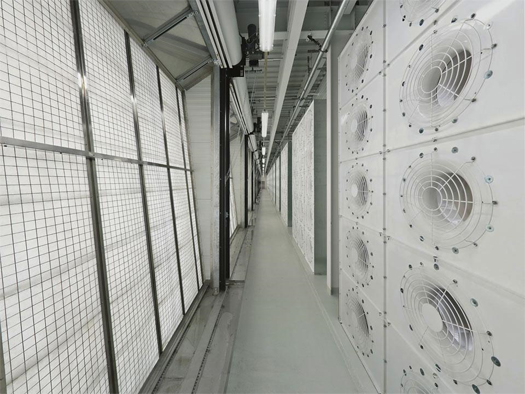
[“Interior components of the cooling system” at a Facebook data center in Palo Alto; image via Alexis Madrigal’s report for Domus on Facebook’s Open Computer Project, which “describes in detail how to construct an energy-efficient data centre”.]
“Secret Servers”, an article by James Bridle originally published in issue 099 of Icon magazine, looks at the relationship between architecture and the physical infrastructure of the internet. I found Bridle’s last few paragraphs particularly provocative:
“What is at stake is the way in which architects help to define and shape the image of the network to the general public. Datacenters are the outward embodiment of a huge range of public and private services, from banking to electronic voting, government bureaucracy to social networks. As such, they stand as a new form of civic architecture, at odds with their historical desire for anonymity.
Facebook’s largest facility is its new datacenter in Prineville, Oregon, tapping into the same cheap electricity which powers Google’s project in The Dalles. The social network of more than 600 million users is instantiated as a 307,000 square foot site currently employing over 1,000 construction workers—which will dwindle to just 35 jobs when operational. But in addition to the $110,000 a year Facebook has promised to local civic funds, and a franchise fee for power sold by the city, comes a new definition for datacenters and their workers, articulated by site manager Ken Patchett: “We’re the blue collar guys of the tech industry, and we’re really proud of that. This is a factory. It’s just a different kind of factory then you might be used to. It’s not a sawmill or a plywood mill, but it’s a factory nonetheless.”
This sentiment is echoed in McDonald’s description of “a new age industrial architecture”, of cities re-industrialised rather than trying to become “cultural cities”, a modern Milan emphasising the value of engineering and the craft and “making” inherent in information technology and digital real estate.
The role of the architect in the new digital real estate is to work at different levels, in Macdonald’s words “from planning and building design right down to cultural integration with other activities.” The cloud, the network, the “new heavy industry”, is reshaping the physical landscape, from the reconfiguration of Lower Manhattan to provide low-latency access to the New York Stock Exchange, to the tangles of transatlantic fiber cables coming ashore at Widemouth Bay, an old smuggler’s haunt on the Cornish coast. A formerly stealth sector is coming out into the open, revealing a tension between historical discretion and corporate projection, and bringing with it the opportunity to define a new architectural vocabulary for the digitised world.”
Though Bridle does not make this link explicit in the article, the idea of a potential “new architectural vocabulary” is clearly related to the “New Aesthetic” that Bridle began talking about this past May. (I’ve always liked Matt Berg’s description of it as a “sensor vernacular”, and Robin Sloan’s “digital backwash aesthetic”. I’m not sure either of those capture exactly what Bridle’s been talking about — more like pieces of it — but they all dance around the same set of things, or at least similar sets.) Here’s Bridle’s original description, pinched together:
For so long we’ve stared up at space in wonder, but with cheap satellite imagery and cameras on kites and RC helicopters, we’re looking at the ground with new eyes, to see structures and infrastructures.
The map fragments, visible at different resolutions, accepting of differing hierarchies of objects.
Views of the landscape are superimposed on one another. Time itself dilates.
Representations of people and of technology begin to break down, to come apart not at the seams, but at the pixels.
The rough, pixelated, low-resolution edges of the screen are becoming in the world.
And when that — a new aesthetic vocabulary — gets linked to a “re-industrialization”, pulling together aesthetics, culture, economics, and politics, you’ve got a pretty significant project. I’d like to talk about this at more length later, but for now I will just quote from Dan Hill’s fantastic 14 Cities project. (Independent of the concerns in this post, the whole project is worth a read.) This is the fourth of the fourteen fictional future cities Hill describes, “Re-industrial City”:
“The advances in various light manufacturing technologies throughout the early part of the 21st century — rapid prototyping, 3D printing and various local clean energy sources — enabled a return of industry to the city. Noise, pollution and other externalities were so low as to be insignificant, and allied to the nascent interest in digitally-enabled craft at the turn of the century, by the early 2020s suburbs had become light industrial zones once again.
Waterloo, Alexandria and the Inner West of Sydney through to Pyrmont once again became a thriving manufacturing centre, albeit on a domestic scale, as people were able to ‘micro-manufacture’ products from their backyard, or send designs to mass-manufacture hubs supported by logistics networks of electric delivery vans and trains. Melbourne had led the way through its nurturing of production in the creative industries and its existing built fabric.
In an ironic twist, former warehouses and factories are being partially converted from apartments back into warehouses and factories. Yet the domestic scale of the technologies means they can coexist with living spaces, actually suggesting a return to the craftsman’s studio model of the Middle Ages. The ‘faber’ movement — faber, to make — spread through most Australian cities, with the ‘re-industrial city’ as the result, a genuinely mixed-use productive place — with an identity.”
[For more on the New Aesthetic, read Rob Walker’s recent interview with James Bridle at Design Observer. It’s also well-worth checking out the essay in Domus by Alexis Madrigal that the image at top is taken from.]


Sweet.